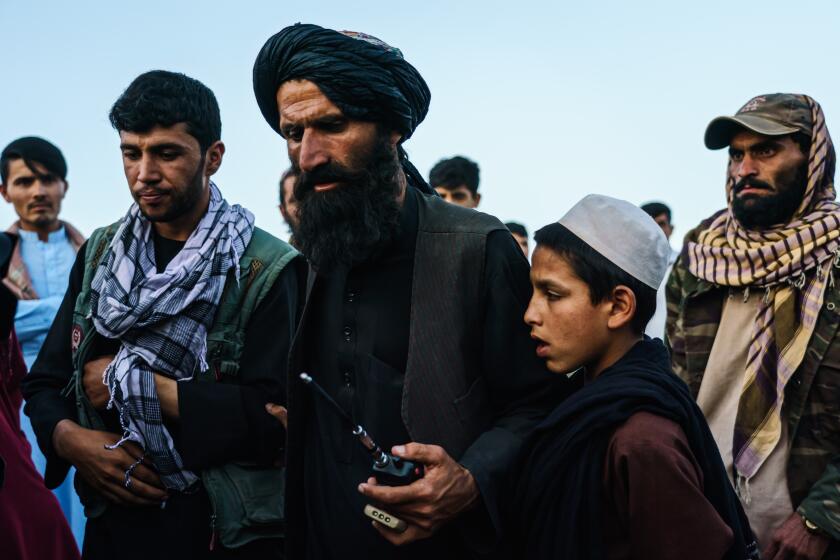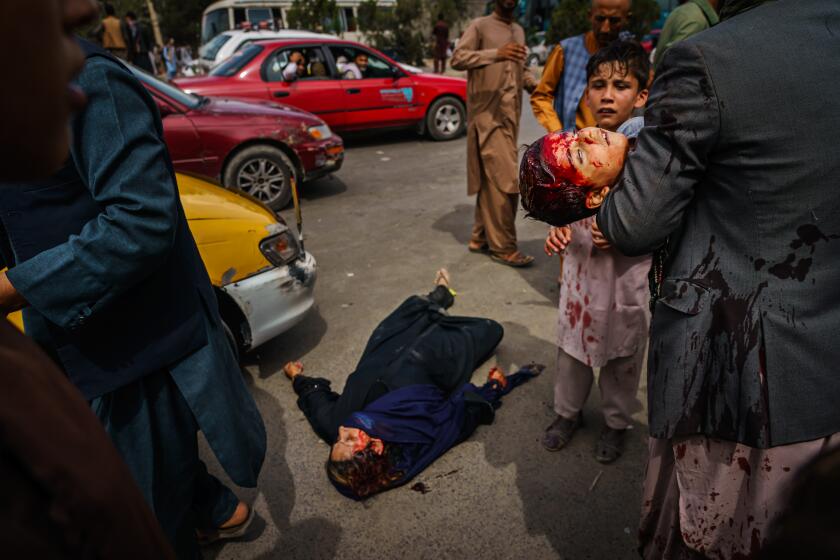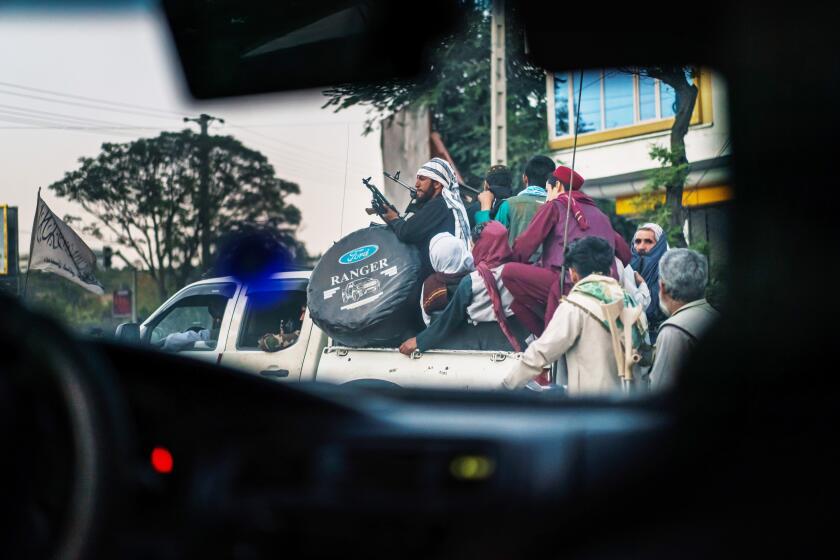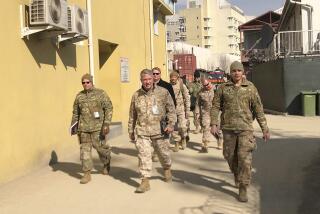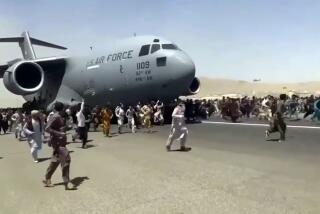News Analysis: What went wrong in Afghanistan?
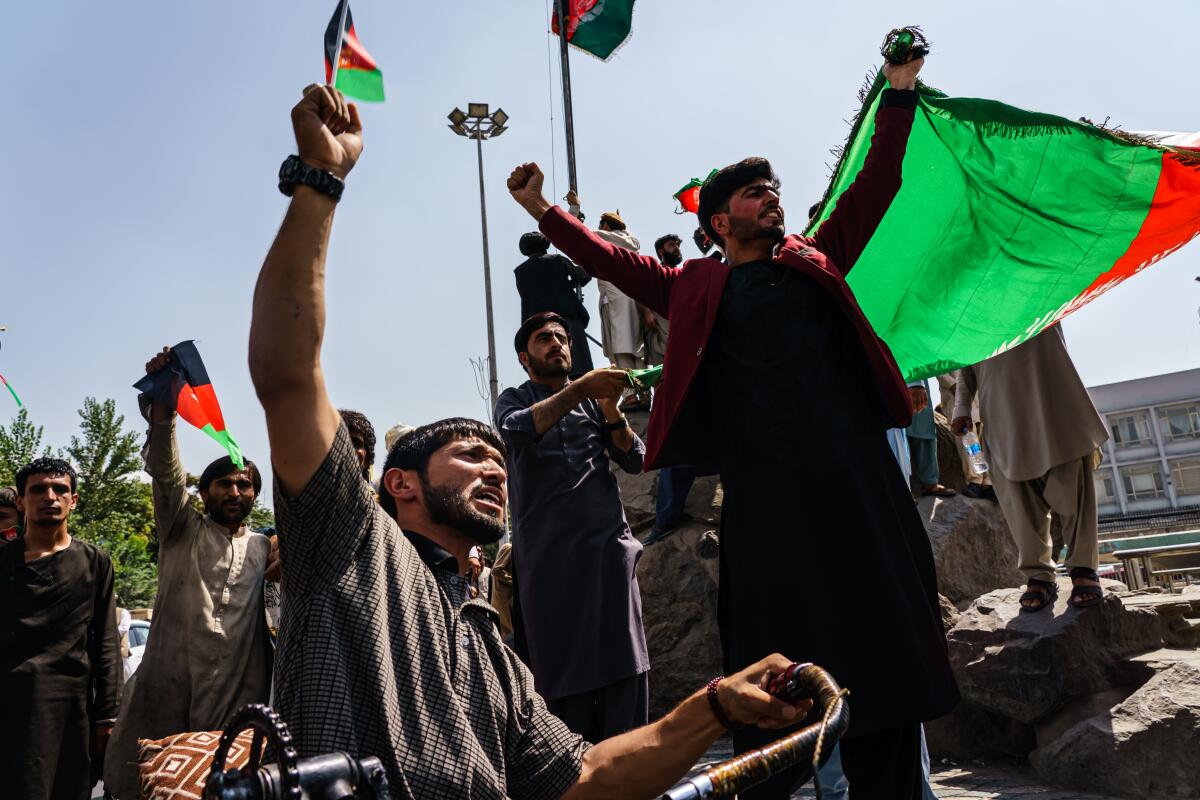
- Share via
WASHINGTON — Twenty years ago, the mission seemed direct, clear and just: Invade Afghanistan and pursue, capture or kill Osama bin Laden, mastermind of the Sept. 11 terrorist attacks, and his armed band of followers.
Achieving that goal also included overthrowing the Taliban, and steadily the mission morphed into a vast, complicated experiment to reshape a society that few Americans understood.
After a war stretching over four U.S. presidencies and costing more than a trillion dollars and tens of thousands of lives, the once-routed Taliban has retaken power in a swift march across Afghanistan, barely meeting resistance, occupying the presidential palace and driving the remaining U.S. troops to a single redoubt: an airport now swamped with Afghans desperate to flee.
Join our journalists for a live chat about Afghanistan.
At noon Thursday, Times global affairs correspondent Laura King, Middle East bureau chief Nabih Bulos, photographer Marcus Yam and foreign editor Jeffrey Fleishman will host a Twitter Spaces event to discuss the latest developments in Afghanistan. Click here to set a reminder for the event.
Despite its military might, expertise and investment, the United States badly miscalculated the speed and absolutism with which the Taliban would overtake Afghanistan and is handing a battered country back to the very people the U.S. sought to defeat, with any gains in nation-building, education and civil rights in jeopardy.
Why? And who is to blame?
The Afghan army “chose not to fight for its country,” U.S. national security advisor Jake Sullivan said Monday, hours after Taliban militants entered the capital, Kabul, and occupied the president’s residence.
On Wednesday, as criticism of the withdrawal mounted, and finger-pointing and postmortems began, Army Gen. Mark A. Milley, chairman of the Joint Chiefs of Staff, concurred while also recognizing broader blame.
Afghan security forces “had the training, the size, the capability to defend their country,” he said at a tense briefing at the Pentagon. “This comes down to the issue of will and leadership. I did not, nor did anyone else, see a collapse of an army that size in 11 days.”
In fact, the reality is much more complicated. Putting all of the blame on the Afghan army, government and people ignores U.S. directives, policy and lack of knowledge. It’s also a hollow analysis of what the United States was trying to do in Afghanistan in the two decades since President George W. Bush launched the initial invasion.
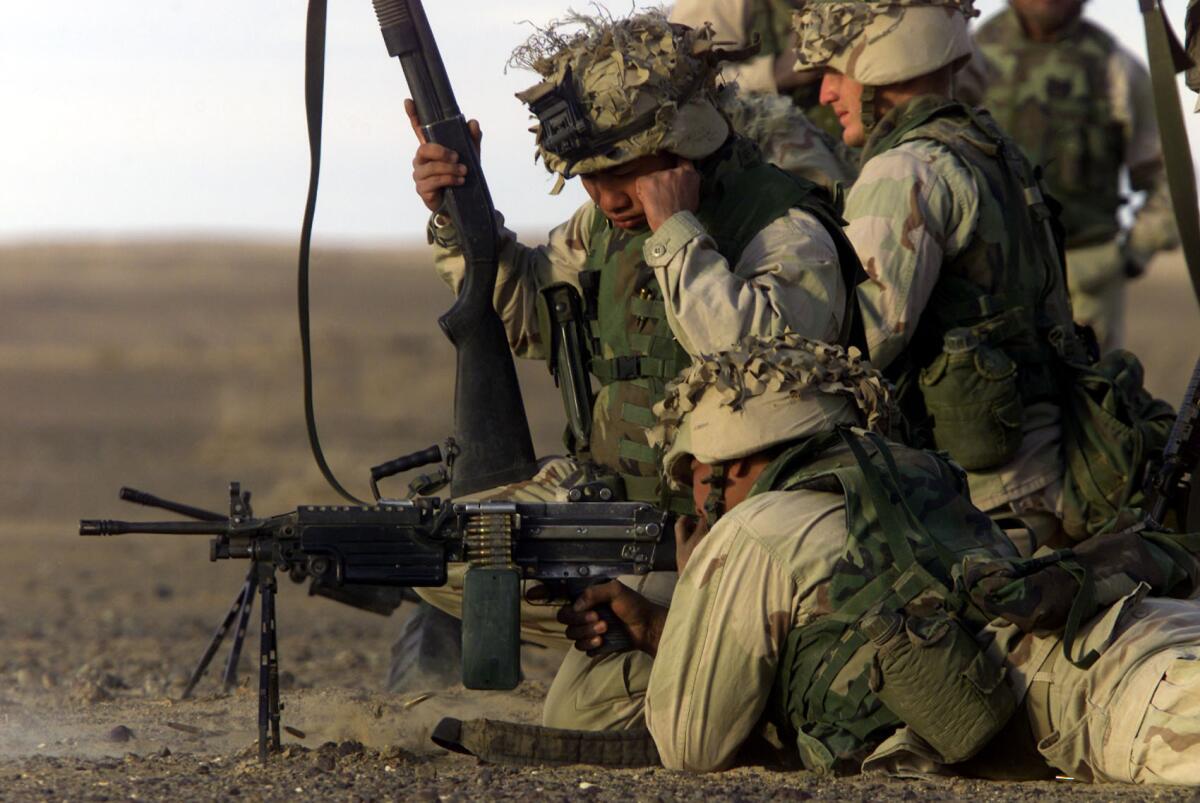
The invasion
For years, Bin Laden’s Al Qaeda terrorist network thrived in Afghanistan under the Taliban, which then ruled most of the country. Shortly after Al Qaeda attacked the U.S. on Sept. 11, 2001, killing nearly 3,000 people, Bush dispatched American troops to Afghanistan to hit the terrorist group where it lived.
It took a decade to finally assassinate Bin Laden, in 2011, in Pakistan. One distraction during that decade was Bush’s ill-fated decision to launch a second war in Iraq, despite the country having no relation to the Sept. 11 attacks. Today, military officials and analysts say the threat from Al Qaeda is diminished but not gone. Al Qaeda franchises have sprung up in parts of Africa, for example, where they did not operate previously. Moreover, according to the United Nations, the Taliban never completely severed its ties to Al Qaeda, despite its pledge to do so.
The Taliban surrendered in December 2001, although many of its forces hid in impenetrable mountain ranges or in neighboring Pakistan and other countries. But the U.S. mission was just beginning. It shifted to “nation-building,” an attempt to construct democratic institutions, to open civil rights for all, including women, and to fashion a system of freedom familiar to the West but unknown in Kabul.
It included missteps, many experts say, that the U.S. military and its civilian partners have often made — misjudging local cultures from Vietnam to Bosnia-Herzegovina, botching realistic goals and making serious errors.
The Taliban pledges to restore calm in Afghanistan, eschew revenge and respect women’s rights — up to a point. Many Afghans still seek to flee.
Creating a dependent army
Many observers now are questioning how an army built with nearly a trillion dollars in U.S. and NATO funding over two decades and tons of materiel — from rockets to Humvees — could so quickly collapse. It appears that as the Taliban marched across the country in the last couple of weeks, its fighters met little resistance from the U.S.-trained military.
Reports from several provincial capitals said local elders and tribal chieftains negotiated with advancing Taliban troops, agreeing not to raise arms against them in exchange for a peaceful resolution. Some Afghans say that arrangement extended nationwide.
“The leadership at one point gave up and told the security forces not to resist,” Roya Rahmani, until last month the Afghan ambassador to the U.S., said this week. “Over the last few weeks, they continuously received calls from Kabul asking them to surrender, asking them not to resist.”
Afghan security forces and ground troops were operating without the air power that had been vital in staving off Taliban advances. At some point — it is not clear when — supportive airstrikes stopped. In recent weeks, the U.S. declined to provide most air support, leaving Afghan troops on their own.
Under U.S. tutelage, the Afghan army became increasingly dependent on its American patrons, so withdrawal of that support was devastating.
“They baked dependency into the Afghan forces,” said Laurel Miller, former acting special envoy for Afghanistan now at the International Crisis Group, describing the U.S. strategy.
She said U.S. efforts too frequently ignored facts on the ground, underestimated the sway of powerful regional warlords and failed to sufficiently take into account vast corruption and the collapse in morale among the rank and file as well as deficiencies in Afghan leadership and command.
Miller and others also gave some credit to the Taliban as fighters — fiercely dedicated and zealously motivated. Strategically, the Taliban, as it sought to regroup, concentrated many of its operations in northern Afghanistan, preventing a resurgence of the so-called Northern Alliance — militias that helped initially to defeat the Taliban. It continued to grow stronger even during a massive, temporary troop surge ordered by President Obama.
The U.S. military made a major mistake in trying to create an army replicating U.S. standards, which made little sense in Afghanistan, said James Stavridis, former NATO supreme allied commander with responsibility for Afghanistan.
“I believe we probably trained them in a way that did not prepare them for this kind of moment in the sense that we tried to make them a mini version of ourselves,” he told MSNBC. “Dependent on intelligence, dependent on air cover, that was not as it turns out the force that was needed to defeat the Taliban.”
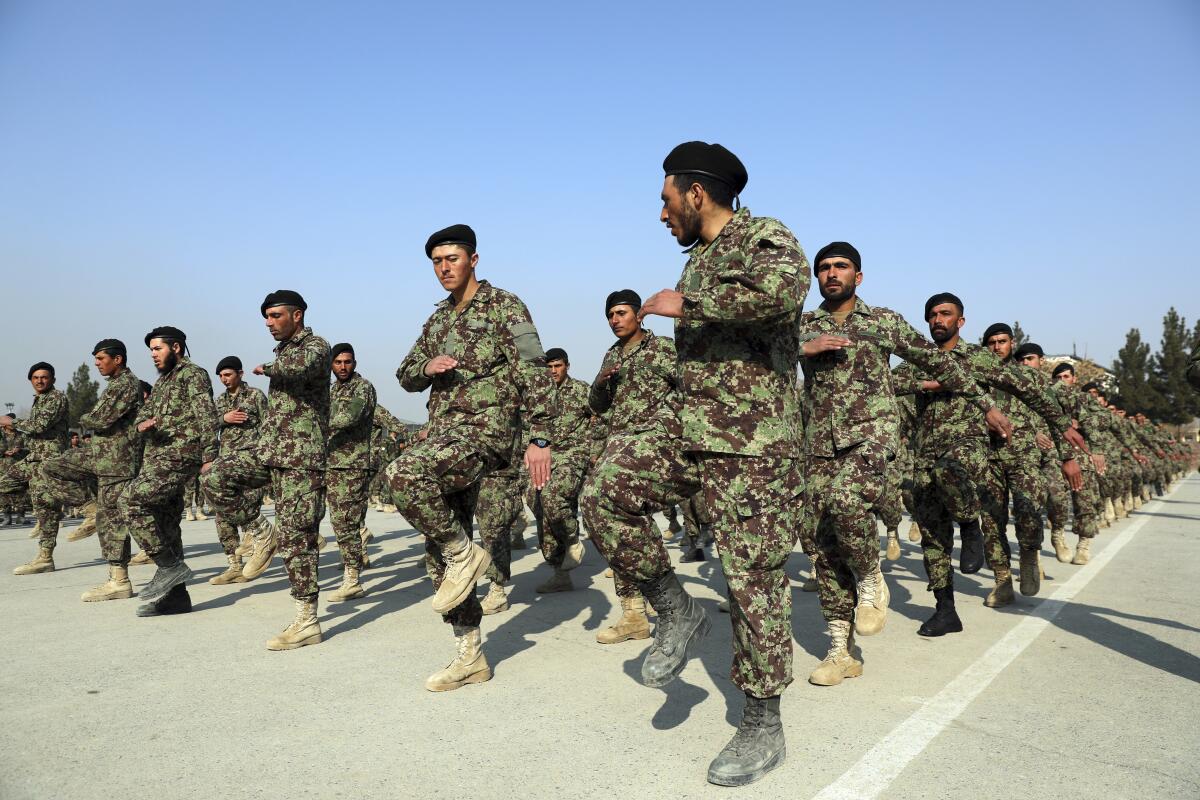
Corruption and ‘missing leadership’
The levels of corruption in the Afghan military and government were something U.S. officials never came to terms with.
The Biden administration has repeatedly asserted that the Afghan army was a fighting force of 300,000, dwarfing the Taliban. But the payrolls of the Afghan military and police contained thousands of “ghost” soldiers, fighters who did not exist but were listed so officials could abscond with their payments.
A government watchdog, the special inspector general for Afghanistan reconstruction, or SIGAR, in recent years found a gap between recorded and actual strength levels in the tens of thousands of personnel; in southern pro-Taliban provinces, 50% to 70% of police positions were filled by people who did not exist, the agency found.
The widespread corruption also served to demoralize the Afghan fighting forces, which by many accounts were formidable and relatively professional. By the final months, with it clear the Americans would be leaving and the Taliban gaining clout in Moscow and Beijing, many Afghan fighters lost hope. They were not being paid; they often had no food or ammunition.
Biden administration officials, confronting images this week of Afghans attempting to storm U.S. military aircraft at the Kabul airport to escape the country, continued to put blame on the Afghan leadership. Afghan President Ashraf Ghani on Sunday fled his country as the Taliban was taking over, leaving no transitional government in place.
The Taliban swept into Kabul and seized power on Sunday after President Ashraf Ghani fled the country.
“You can resource, you can train, you can support, you can advise and you can assist, but you cannot buy will,” Pentagon spokesman John Kirby said Monday in explaining the collapse of the Afghan government. “You cannot purchase leadership, and leadership was missing.”
The Afghan government’s leadership, however, was left out of the deal the Trump administration made with the Taliban.
The Trump-Taliban deal
The withdrawal from Afghanistan was ordained by former President Trump, whose government sat down with the Taliban last year — the first U.S. representatives ever to do so — to essentially negotiate a withdrawal agreement. It did little to address broader issues in the country, and it completely sidelined the Afghan government.
Trump set a withdrawal deadline of May, and President Biden insisted he was bound by what Trump negotiated — even though the Taliban violated many terms of the pact. They did stop attacking American forces, but did not reduce other violence. Biden, calling the war in Afghanistan unwinnable, set a new deadline of Sept. 11, with the drawdown to begin May 1. He later moved the deadline up to Sept. 1.
The fall to the Taliban was “driven by the fact that both President Trump and President Biden not only announced deadlines for the withdrawal of U.S. military support, but they then cut that support to levels where Afghan forces could not survive and where many Afghan politicians and government figures were willing to stand aside or surrender,” Anthony Cordesman, a veteran analyst for the Center for Strategic and International Studies, said in an essay this week.
But, Cordesman added, the swift rise of the Taliban “is the collapse of a house of cards that took some 20 years to build and that was driven as much by failures at the civil level as the military level.”
Recriminations
“There’s a dark irony here,” said Benjamin Friedman, policy director with Defense Priorities, a Washington group that supports U.S. withdrawal from Afghanistan. Despite the tragic and lethal messiness of the last days, he said, Afghanistan may be more at peace soon than in a long time — although widespread repression of minorities, women, dissidents and others will undoubtedly be reimposed. But the military, civilian officials and experts will have to be held accountable, he said, “for how they got it so wrong.”
“You could not imagine a more stunning rebuke for the U.S. nation-building project,” he said. “We were building a failed state, not fixing a failed state.”
A state, he added, that was overly reliant on foreign aid and shaped by a history of armed faction and competing tribal power centers.
A new report issued by SIGAR on Tuesday included a litany of U.S. mistakes and judged the overall situation in Afghanistan as “bleak.”
“The U.S. government did not understand the Afghan context and therefore failed to tailor its efforts accordingly,” the watchdog said.
Protesters in Jalalabad who tried to raise the Afghan national flag in place of the Taliban’s were dispersed by fighters wielding weapons.
“Ignorance of prevailing social, cultural and political contexts in Afghanistan has been a significant contributing factor to failures at the strategic, operational and tactical levels.”
Some critics of Biden’s handling of the withdrawal have suggested he could have kept a contingent of forces in Afghanistan to preserve what was essentially a stalemate between the U.S.-backed government and the Taliban.
Annie Pforzheimer, former deputy chief of mission of the U.S. Embassy in Kabul, said the stalemate was at least better than the current scenes of black-clad Taliban whipping residents and going door to door possibly in search of Afghans who worked with Americans.
“It was working to keep the Taliban out of the provincial capitals, and that was an important status,” she said. “Were most Afghans running in fear? Were we airlifting people out of Kabul? The status quo wasn’t great, but this is far worse.”
Biden, however, was adamant, and many inside and outside the administration were convinced that, rather than a stalemate, the Taliban would launch new warfare if U.S. troops didn’t begin to withdraw by the date Trump promised.
“How many more generations of America’s daughters and sons would you have me send to fight Afghanistan’s civil war when Afghan troops will not?” Biden said this week in defending the withdrawal. “How many more lives — American lives — is it worth? How many endless rows of headstones at Arlington National Cemetery?”
More to Read
Get the L.A. Times Politics newsletter
Deeply reported insights into legislation, politics and policy from Sacramento, Washington and beyond. In your inbox three times per week.
You may occasionally receive promotional content from the Los Angeles Times.
